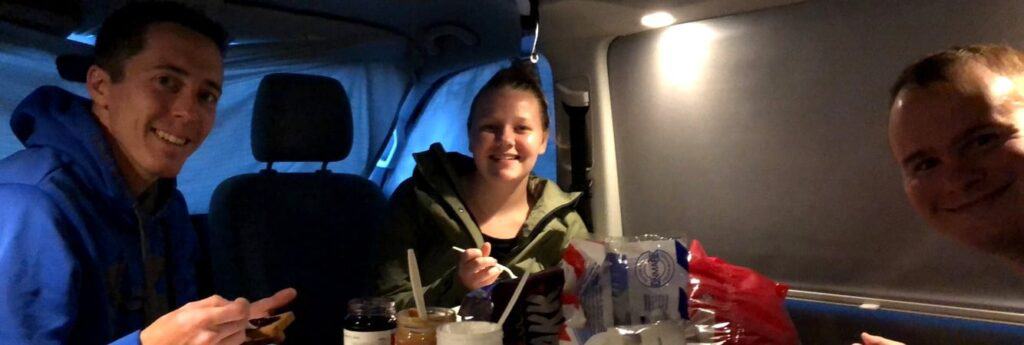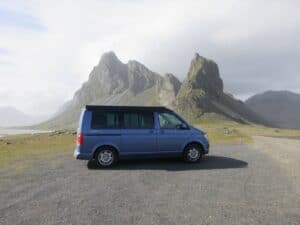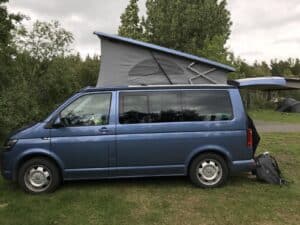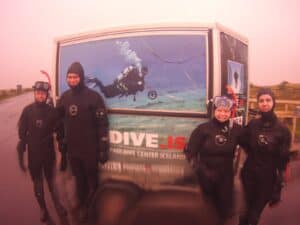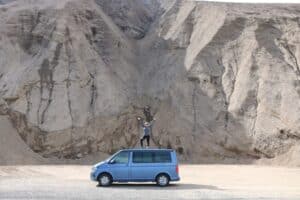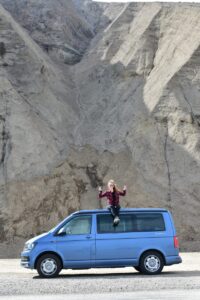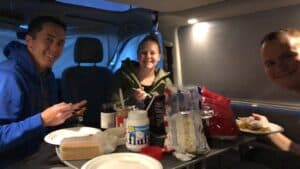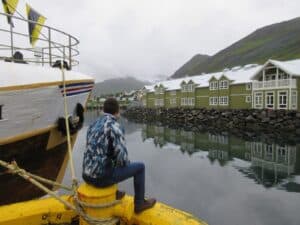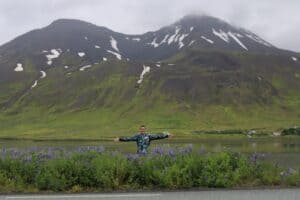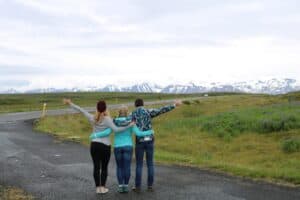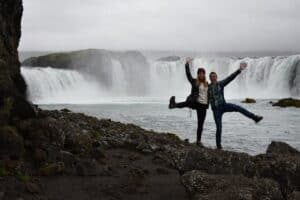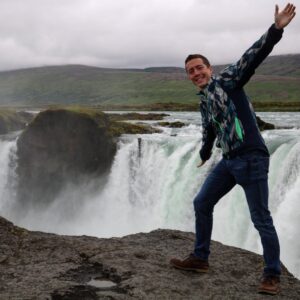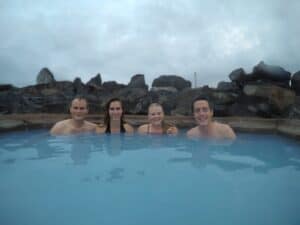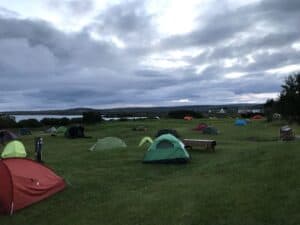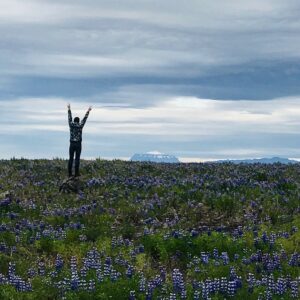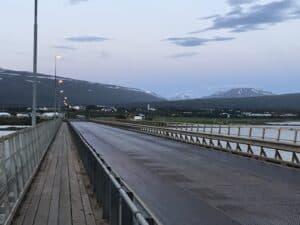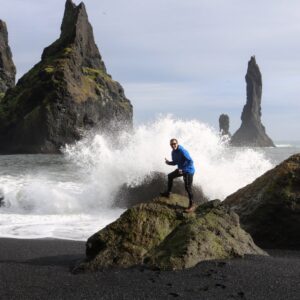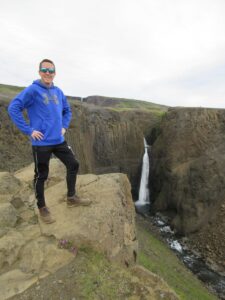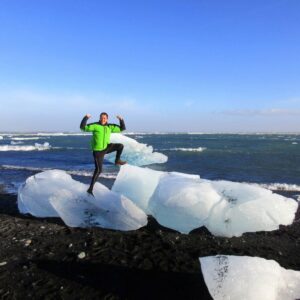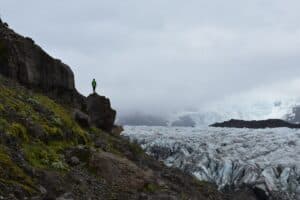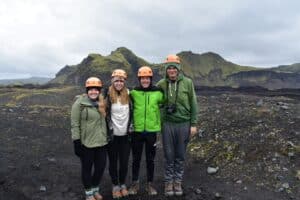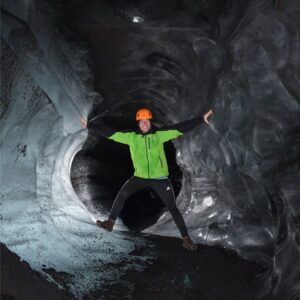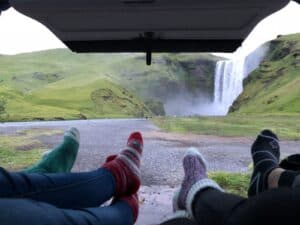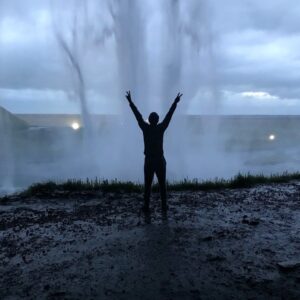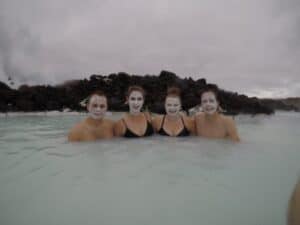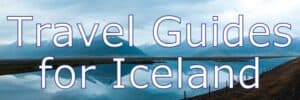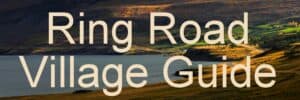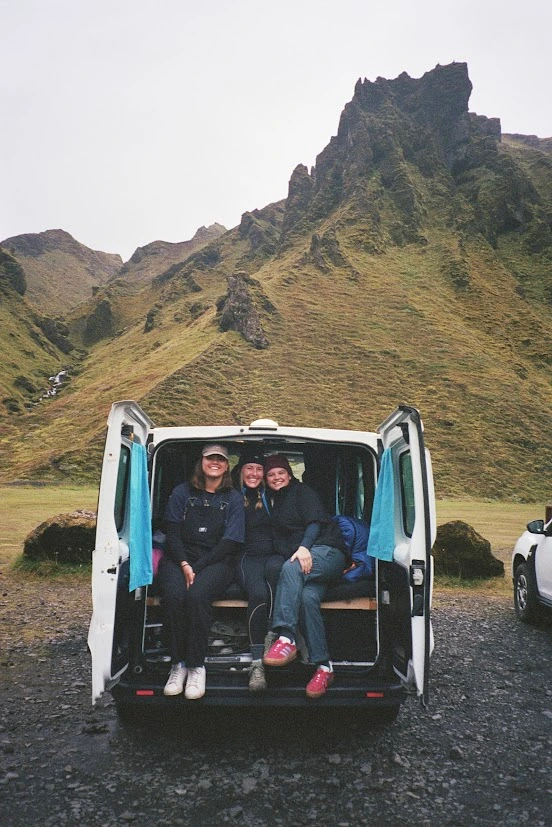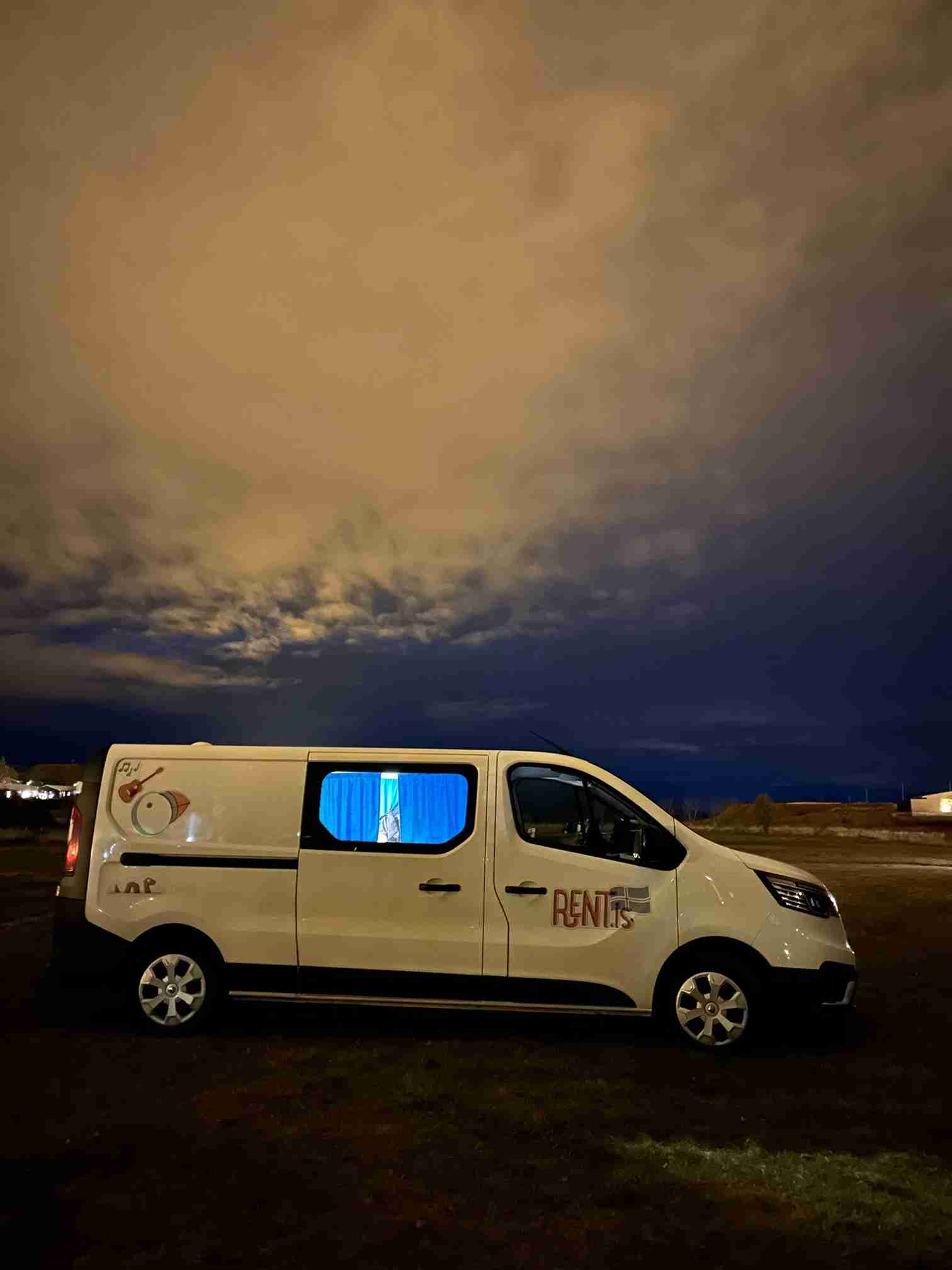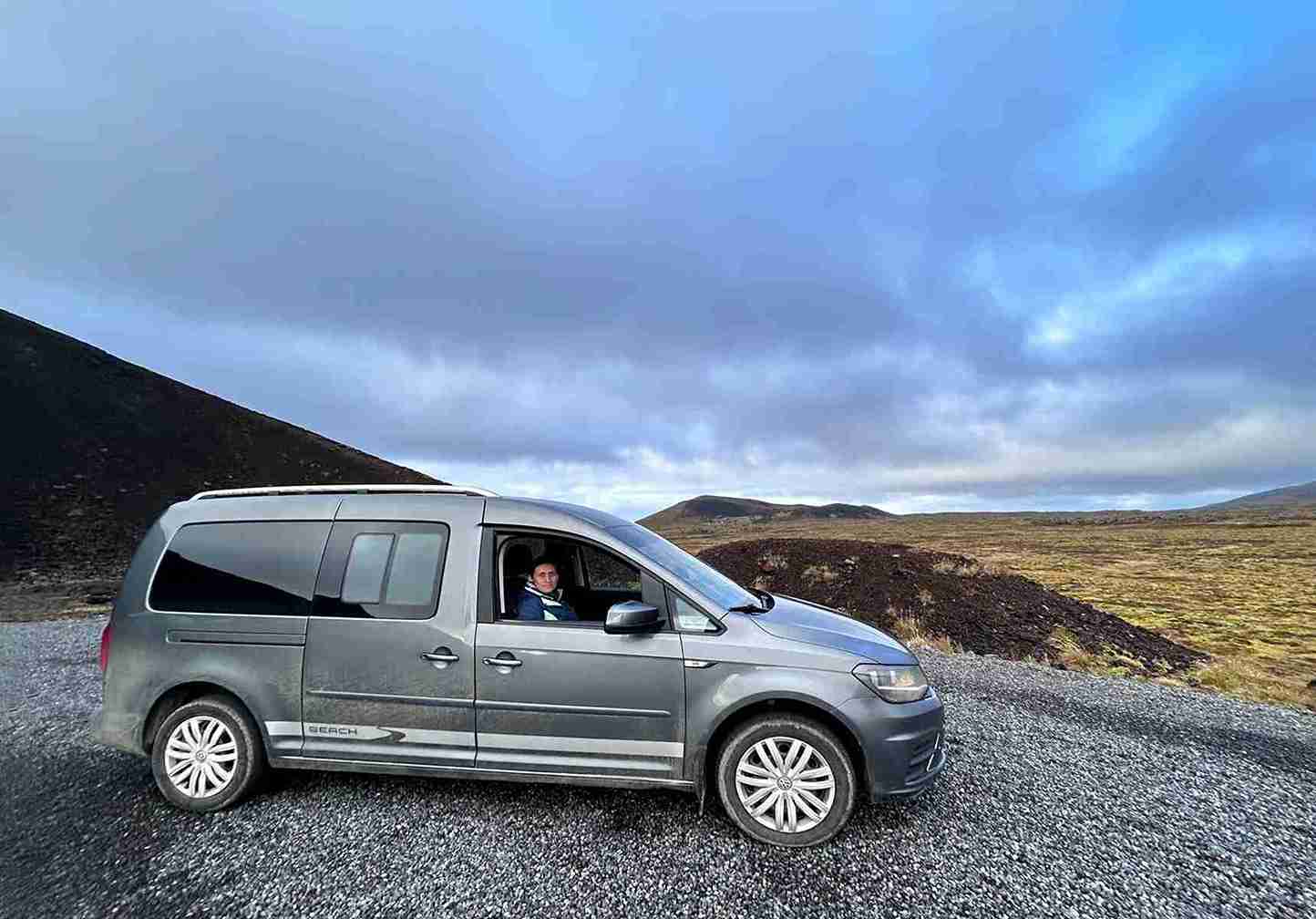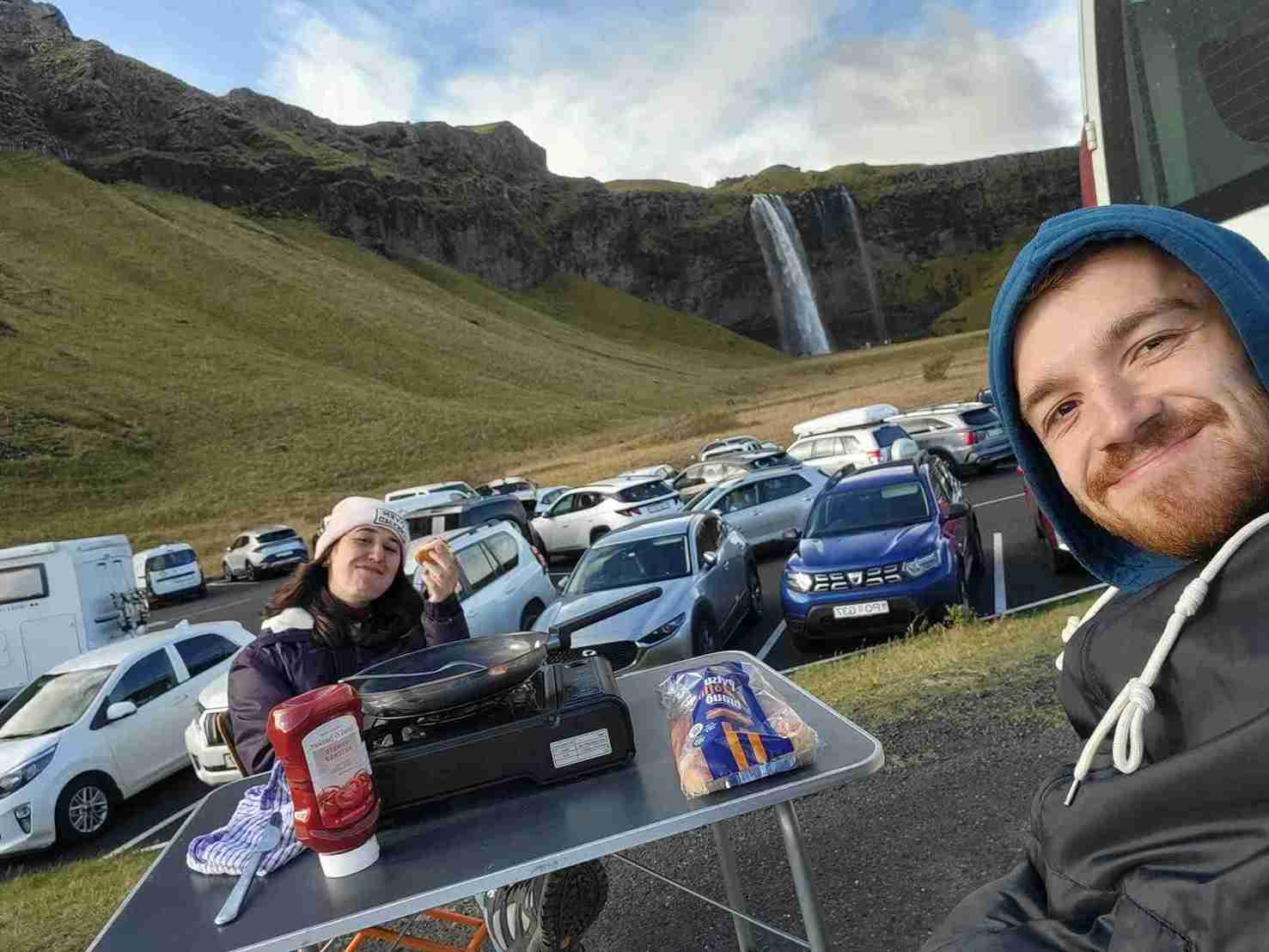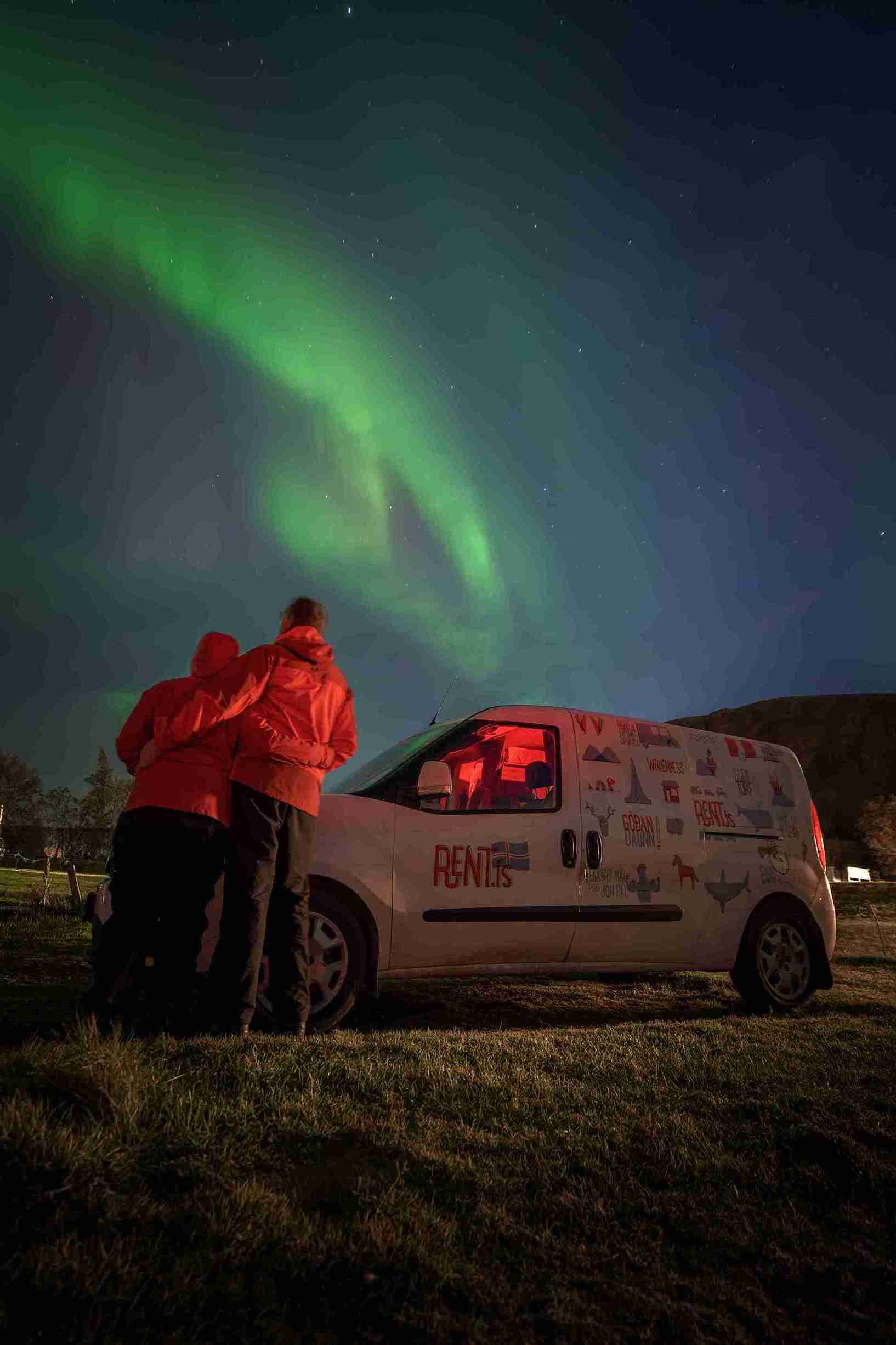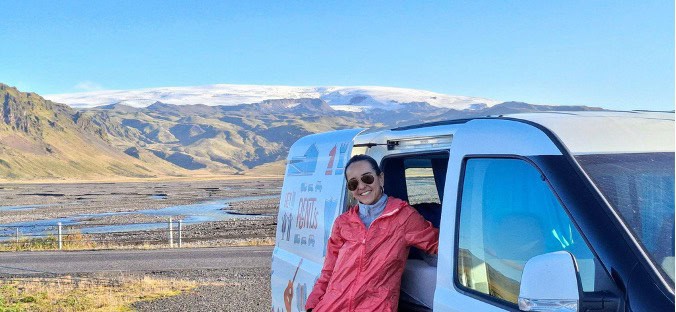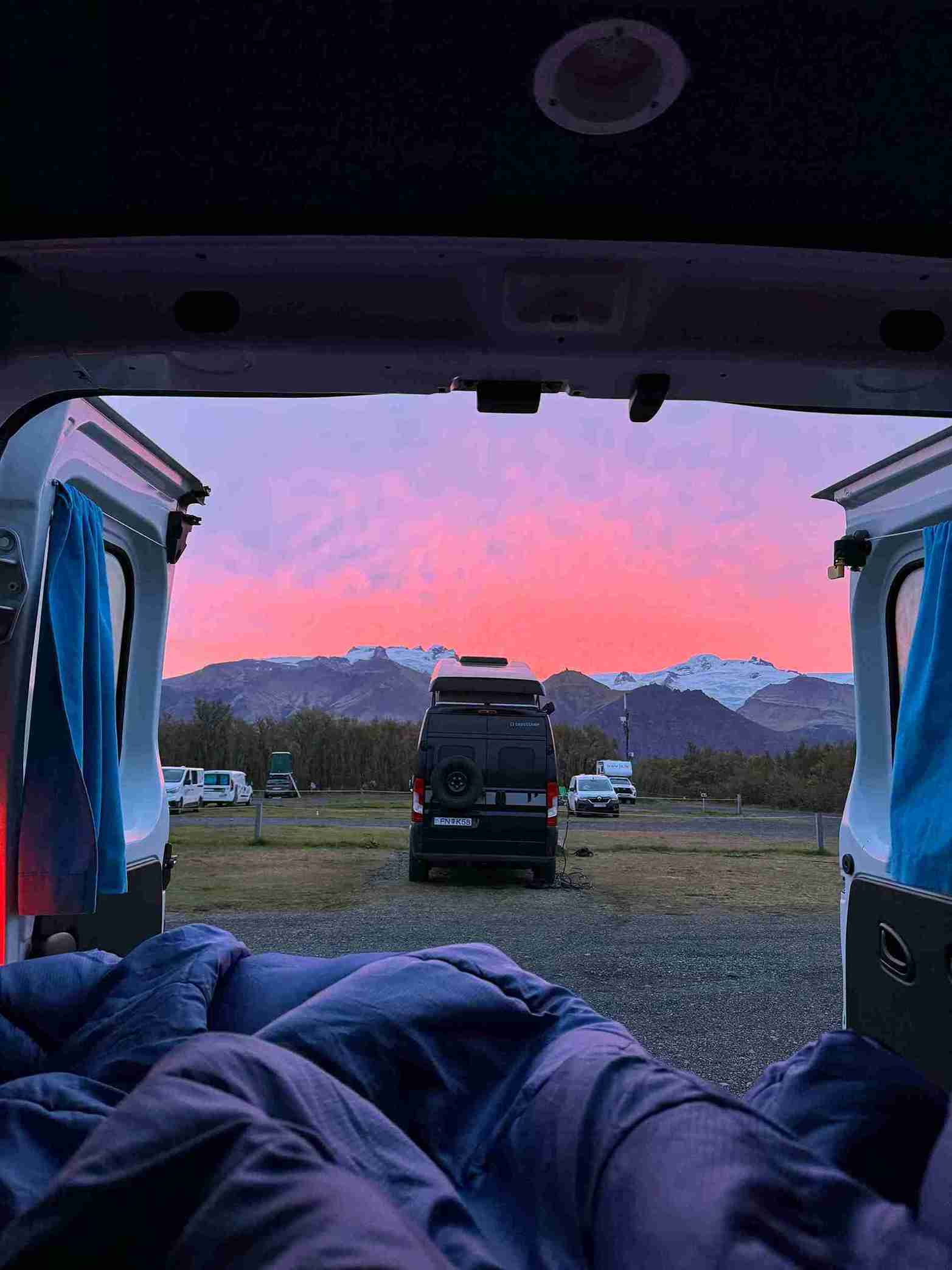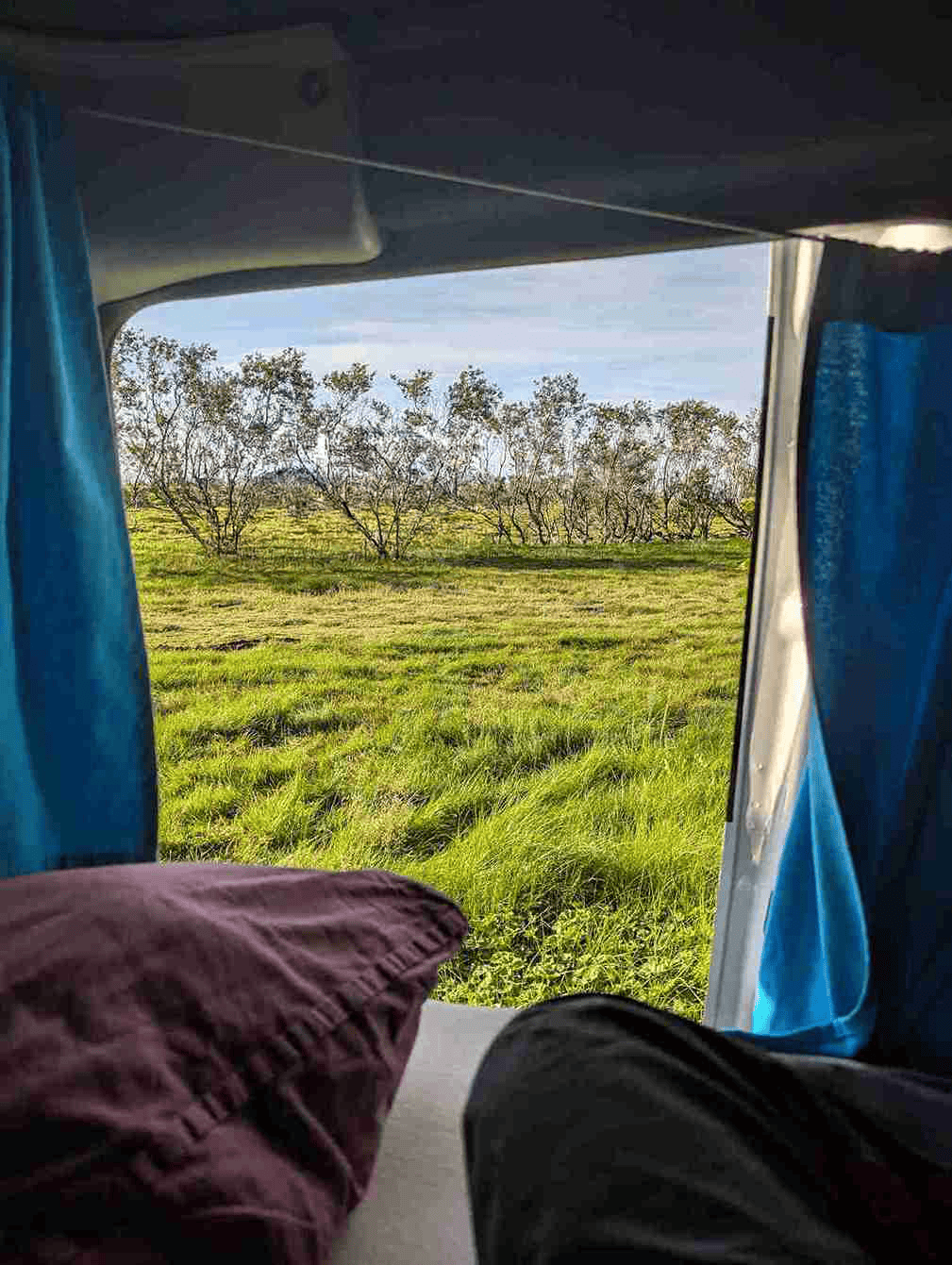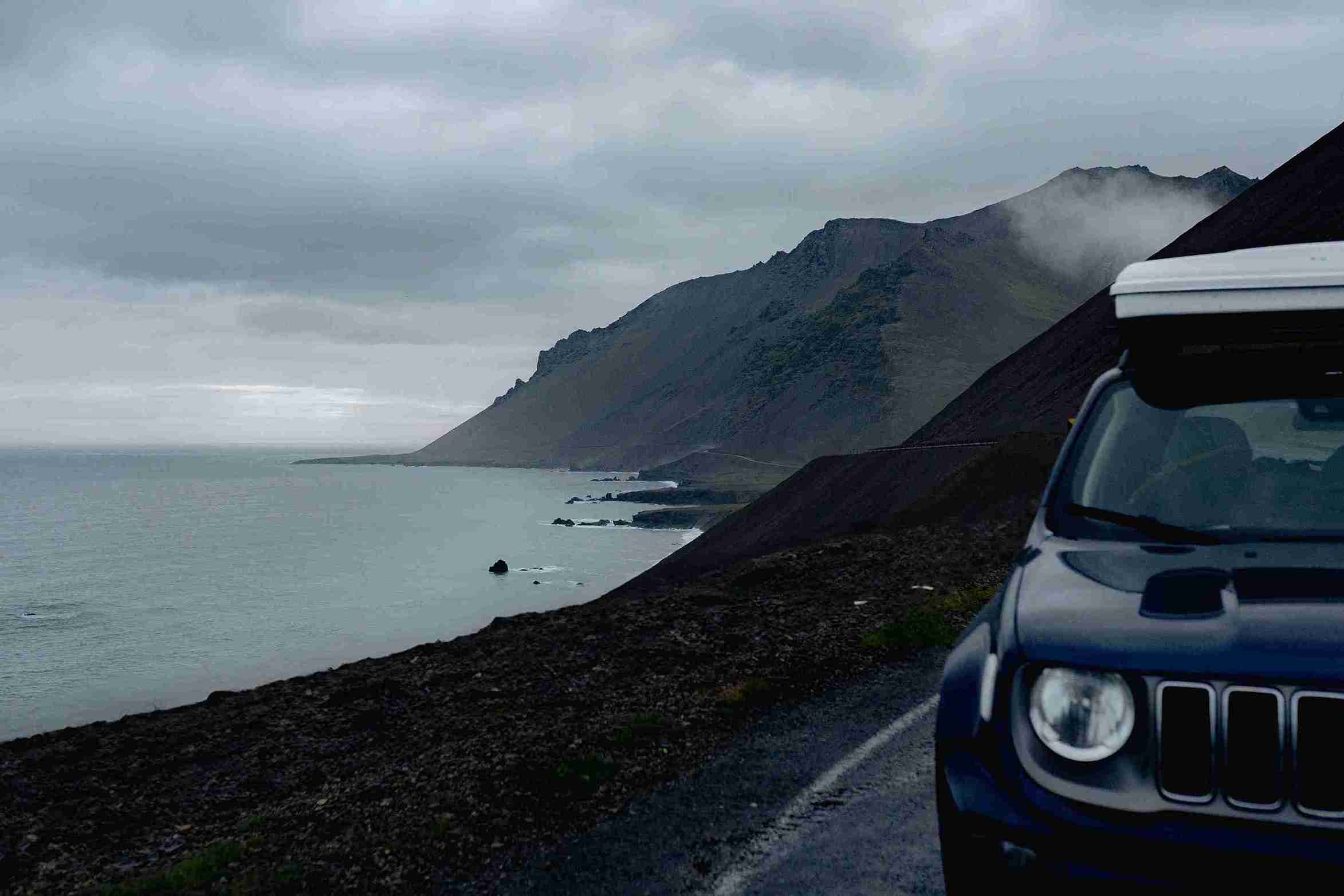Iceland’s Midnight sun
6 July 2018
Silfra Snorkeling
Can you believe it is 12:30 in the morning and there is still daylight visible out of our 4×4 Camper van as I am writing this blog? My body’s internal clock has no idea what time it is now considering we’ve had a four-hour time change and the setting sun is still visible in the Icelandic sky. Travelling around Iceland’s famed Ring Road (Route 1) in five days, I’m anxious to see how light it will be as we near the Arctic Circle in our camper van. Running on diesel, our camper van can comfortably sleep four people, so Alyssa, Shaina, Zach, and I are all set, even with our own provided sleeping bags. Our camper van has everything we need to make it possible to travel the Ring Road in a short amount of time before we continue on to Europe. The roof pops up to accommodate two passengers to sleep above the vehicle, there are chairs and a table inside, and we even have WiFi, to make the reading of this blog possible. We are definitely satisfied with our decision to rent a camper van rather than stay at Airbnbs and rent a vehicle during our time in Iceland.
We spent our first day driving around Reykjavík, the capital of Iceland and the northern most capital in the world, to stop at Bónus (a grocery store to stock up on groceries to live off of in our camper van) before making our way up to Silfra. Arriving at Silfra, we had a scheduled dive of the glacial lake at 16:00, which would not have been possible if it weren’t for the midnight sun. With the Earth’s Northern Hemisphere tilted towards the sun, Iceland experiences an incredible amount of sunlight during the summer months. If we were to arrive in winter to snorkel Silfra (yes, it is still possible) the darkness of the early-setting sun would have prevented us from snorkeling.
We were so excited we could snorkel at 16:00 after our flight had arrived earlier that morning. Never have I ever been snorkeling in thirty-seven degree water, but it was a memorable experience I will never forget. It is the only place in the world where you can see two tectonic plates clashing. We saw the Eurasian Plate meet the North American Plate at the largest lake in Iceland, Þingvallavatn. The water was so clean that our tour guide even told us to drink water straight from the lake. The water comes from a glacier north of the lake, and the water travels to the mantel of the Earth at depths of eight miles before resurfacing-It takes 20-30 years for this process to take place. The water was crystal clear and absolutely freezing, but thankfully, our dry suits kept us warm and is definitely the highlight of today.
We then drove along the Ring Road on Route 1 and finished the day by visiting Grábrók Volcano (which has been inactive for quite some time) at 23:00 at night. It was still daylight out and quite a unique experience. The best part about the midnight sun is the ability to travel and still explore this unbelievable country while it is still light out. What makes it even more enjoyable, is the fact all of the tourists have left the ‘tourist traps’ by this time, so at 23:00 at night, there was no one at Grábrók Volcano except for us, which made it an unbelievable experience before popping up the camper van for some much needed rest. Considering we are sleeping while the sun is still up, our camper van comes equipped with curtains on all windows and sheets to cover the front windshield as well so that we’ll be prepared for tomorrow’s adventures.
7 July 2018
Akureyri Adventures
What a surprise-we went to sleep with daylight still visible and we woke up this morning with the daylight still visible. Haha. What a whirl wind today was being immersed in the Icelandic culture… We drove from Varmahlíð to Siglufjörður which is located up right on the edge of the Arctic Circle, the farthest north I have ever been (Even farther north than Denali, Alaska!)
I spent the day as Captain of our camper van, which we named Frida, after a Chocolate Shoppe we stopped at today. It was quite the experience driving on the edge of cliffs of Northwestern Iceland, without any barriers to stop us, driving through a three-mile and a seven-mile single lane tunnel where cars had to weave into pull offs to let traffic by, and spending over $10,000 Króna on diesel to fill her up.
We clocked in the kilometers as we continued driving through small, Icelandic towns off the beaten path of the Arctic Ocean such as Siglufjörður, where barely anyone spoke English which was quite the experience. We embarked on two docked ships made of solid oak and met the captain, then we found a picturesque location with glaciers melting off the mountaintops with purple lupine for some Icelandic photo-ops. We then drove thru a larger town called Akureyri where the town had hearts for their red lights. Another thing to note is when you are stopped at a red light in Iceland, and the cross traffic’s traffic signal turns yellow, your traffic signal lights up not the stationary red, but yellow as well to let you know the light is about to turn green. #Efficient
We then checked off visiting a geothermal cave where the Game of Thrones was filmed where I rock-climbed to the top, visiting Goðafoss Waterfall (Waterfall of the Gods), and relaxing in Mývatn Thermal Springs – A natural blue lagoon that is forty-one degrees Celsius (105 degrees Fahrenheit) to end our day.
We had such a relaxing time at the Mývatn Thermal Springs; we stayed there until midnight when they closed. I’ll state again, another positive to staying up late is there are hardly any tourists out. That was the case at midnight at Mývatn Thermal Springs, for we practically had the place to ourselves! Our bodies are so disorientated because as I am typing this at 1:30, the sun is still up! I have no sense of time or direction here, but I do have a sense of the Icelandic culture and the experiences I am making with my friends in Iceland.
8 July 2018
Leirhnjukur Lava
Where’s the sunscreen? We awoke this morning to the sun brightly shining outside our camper van. Thank goodness for the privacy curtains! We had Icelandic Yoghurt for breakfast (which is very thick and creamy) and then we were on our way to explore hot springs, volcanoes, and lava fields. As the designated driver again today, we drove over five and a half hours on the back roads of Iceland searching for adventures. The midnight sun was to our advantage to allow for extra hours of daylight to explore this magnificent country in Frida, our camper van.
Our first stop brought us to Námafjall Hverir Mud Pots-where Hydrogen Sulfide and steams were spewing out of the ground. It was spectacular and probably the highlight of my day-even though we reeked of sulfur, which smelled like rotten eggs, when we got back in the camper van. Thankfully, we were smart enough to pack Lysol Wipes and dryer sheets to help freshen the camper van considering a lot of our clothes are damp from the moist air here in Iceland. We hiked up a cliff that encompassed the mud pots and came down the other end to find steam vents spewing out water and steam at 200 degrees Celsius (424 degrees Fahrenheit).
The second stop took us ten minutes across the street to Krafla volcano that had erupted in the late 1700s, but had been filled in with water that is super blue. We opted not to follow the trail that encompassed the volcano so that we could stop at our third stop – Leirhnjúkur Lava Fields, where the lava had seeped out of the Earth’s crust near Krafla to produce an immense amount of igneous rocks. The thermal vents are still giving off hydrogen sulfide and some very warm water vapor to this day. We visited a small museum afterwards and learned that Iceland produces ninety-seven percent of its energy from geothermal vents-making it a very sustaining natural resource. Why cannot other countries follow the footsteps of Iceland?
Finally, the climax of the day took us twenty-eight kilometers, or roughly eighteen miles, on a very bumpy dirt road-filled with potholes and crevices on an off-road excursion that took almost an hour to reach. We trekked up to Dettifoss, Europe’s most powerful waterfall. I thought to myself “This drive better be worth it!” and it certainly was. To see the amount of water falling to the depths of the canyon was captivating. Mother nature was definitely showing off today. We then trekked 1.4 kilometers up the canyon to Selfoss, a very elongated waterfall this was made up of more than twenty waterfalls. Both waterfalls were mesmerizing as we walked along the black sand beaches leading up to them.
Finally, we finished our evening driving an additional three hours to Egilsstaðir, a town on Iceland’s northeast coastline. We ate dinner at Salt Cafe, and then had Icelandic Ice Cream at a traditional American diner in town. I was super excited when I saw a six-lane track in town and decided to go for a seven mile run at midnight. Definitely the first time I have ever run this late at night, all thanks to the midnight sun! I could see clear as day-it was awesome.
9 July 2018
Ginormous Glaciers
Pictures truly do not do justice to see the sheer magnitude of Iceland’s southeast coast. We definitely saved the best part of the island for last, as we are now three-quarters of the way around the perimeter of the island. I thought it was hilarious when we rented the camper van and they asked us if we wanted volcanic ash and sand insurance, and I am so thankful we said yes. Driving down these insane roads that are mainly one lane, the wind is so powerful that you would not believe how much sand I even have in my clothes and hair after walking the black sand beach.
We started our day departing Eglisstadir to fill up Frida with diesel (Diesel when converted from liters to gallons and Króna to US Dollars is running around $7.55/gallon here) and drove to Hengifoss, three waterfalls that feed into a glacial lake. We spent two hours this morning making the ascent to see sheep and a lot of waterfalls. Litlanesfoss, which was my favorite, was formed around lava pillars. Lots of igneous rock there! After our hike, we ate lunch in the camper van and were back on the road to continue on our excursion.
As we left Hengifoss, we drove on a dirt road that had 17% grades without any guardrails. Sheep were crossing the road and we got some awesome shots of the changing landscape of snow covered mountains and glaciers. We then stopped along the coastline at an orange lighthouse-not sure how many people would be boating in the rough, cold seas up here, but it was pretty unique.
We stopped in the town of Höfn for dinner and had Icelandic Pizza which is light crusted pizza with much less sauce and cheese than what we are used to. It definitely hit the spot after a long day of driving and hiking.
We finished the day by visiting Jökulsárlón Glacial Lagoon and Diamond Black Sand Beach. As stated before, it was super windy along the coast line and black sand was flying up into my eyes as we took photos of the icebergs floating out to sea from the glacier. It was very picturesque and we even saw some ducks, seagulls and three seals at 23:00 at night! This midnight sun is allowing us to use our time wisely and pack in as much as possible during our short time here. Tomorrow will involve more snow and ice as we hike into ice caves beneath a non-active volcano in Vik!
10 July 2018
Scaling Skógafoss
Today was a jam-packed day filled with adventures as we finished our 1,094 mile Ring Road Loop around Iceland. Iceland is most known for the topography of the Southeast coast, which is what we covered today as we saw the sheer magnitude of two waterfalls, a glacial hike, an ice cave hike, and a black sand beach as we continued to explore the island of ice and fire.
Our first stop brought us to Skaftafell Glacier, which reminded me a lot of Matanuska Glacier I hiked in Alaska three years prior with my Slippery Rock teammates. The only negative aspect to Skaftafell, is people actually fell off the glacier and did not survive the bone-chilling thirty-three degree murky water, so we did not make it down to the glacier to hike it, but to rather observe its magnitude of all of the unmelted snow that has accumulated year after year from winters in the valley.
After we hiked to Skaftafell Glacier, we drove an hour and forty-five minutes to Vik, a small Icelandic town where we met Stefán, our tour guide that drove us along with eight other adventurers out to two crystal ice caves that had formed from the melting glacier above. After the forty-minute off-road experience in a van on steroids, we put on our protective helmets and crampons on our shoes, which helped us grip the ice. It was a very irreplaceable experience climbing into the glacier and seeing melting glacial water rushing past us for picturesque views, all of which are natural and not man-made.
As we made our way back to Vik, we stopped for a quick snack at the N1 Gas Station. I heard lots of rumors the hot dogs at gas stations in Iceland are amazing so I decided to try it for myself. It was seriously the best hot dog I have had-even better than Smith’s here in Erie. It was covered with fresh, caramelized onions and fried onions. I’m salivating just thinking about it! We then continued on the Ring Road to Reynisfjara Black Sand Beach, which is completely black sand. It was unbelievable lava that had been spewing out of Earth’s crust had hardened and made its way out to sea, where the ferocious Atlantic waves eroded and weathered the lava into tiny sand particles.
The final part of our day brought us to two waterfalls, Skógafoss-where we had our dinner overlooking the falls at 21:00 at night, and then to Seljalandsfoss-my second favorite waterfall to Hengifoss, where we stood behind the massive waterfall. Arriving at 12:00 in the morning, we were (again) the only people at the waterfall, which made it the perfect opportunity to snap some amazing photos. It was a really wet and unique experience to say the least. Finally, we made our way to our campsite for the night, which was three hours away-we never arrived until three in the morning, but the daylight made the drive so much easier considering the setting sun led the way for us.
11 July 2018
Incredible Iceland
With a mere three hours of sleep, we awoke at 6:00 to see the sun was already up (It probably never set) as the winds and rain howled and lashed our camper van in the town of Grindavik. We packed up and took off ten minutes down the road to the Blue Lagoon.
The Blue Lagoon is a man-made Lagoon (unlike Mývatn Nature Baths that we visited earlier that is natural) located near the airport and is definitely a tourist trap. The experience was priceless however as we had 7:00 tickets to basically have the baths to ourselves before all of the tourists arrived. The midnight sun carried into the morning and it was quite light out by the time we arrived. We drank natural Icelandic Glacial water while relaxing in the 102-degree water with our silica face masks. I felt like we were in a zombie apocalypse with everyone walking around in the blue steam covered in silica masks. The reason for the lagoon being blue is due to the fact that silica from Earth’s crust rises to the surface after the geothermal water has traveled forty hours to the surface and reflects the sunlight (or in Iceland, lack there of). The Blue Lagoon was a great way to relax on our last day before we returned the camper van and made our way to Keflavik International Airport for London.
I am so appreciative we chose to visit Iceland in the summer, for the Midnight Sun worked to our advantage-allowing us to travel to tourist destinations in our campervan late at night when no one else was there-allowing us to avoid crowds and enjoy the serenity of nature. The Midnight Sun also allowed for feasibility as we drove through the night to travel Iceland’s famed 828 mile Ring Road in a mere five days. All in all, Iceland was a great place to visit with priceless, picturesque landscapes. It was truly a once-in-a-lifetime trip with memories that will last forever.
Read more: Signs of Iceland
Happy Camping! #CamperStories
Iceland Travel Guides
If you like what you see, please subscribe to our YouTube channel!

